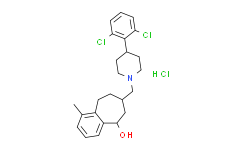| Cas No.: | 371980-98-2 |
| Chemical Name: | 7-[[4-(2,6-Dichlorophenyl)-1-piperidinyl]methyl]-6,7,8,9-tetrahydro-1-methyl-5H-benzocyclohepten-5-ol hydrochloride |
| Synonyms: | 7-[[4-(2,6-Dichlorophenyl)-1-piperidinyl]methyl]-6,7,8,9-tetrahydro-1-methyl-5H-benzocyclohepten-5-ol hydrochloride;(5S,7S)-7-[[4-(2,6-dichlorophenyl)piperidin-1-yl]methyl]-1-methyl-6,7,8,9-tetrahydro-5H-benzo[7]annulen-5-ol,hydrochloride;SB612111;(5S,7S)-7-[[4-(2,6-Dichlorophenyl)-1-piperidinyl]methyl]-6,7,8,9-tetrahydro-1-methyl-5H-benzocyclohepten-5-ol |
| SMILES: | Cl.ClC1=CC=CC(Cl)=C1C1CCN(CC2CCC3=C(C=CC=C3C(O)C2)C)CC1 |
| Formula: | C24H30Cl3NO |
| M.Wt: | 454.860104084015 |
| Purity: | >98% |
| Sotrage: | 2 years -20°C Powder, 2 weeks 4°C in DMSO, 6 months -80°C in DMSO |
| Description: | SB-612111 is a novel and potent human opiate receptor-like orphan receptor (ORL-1) antagonist with a high affinity for hORL-1 (Ki=0.33 nM). SB-612111 exhibits selectivity for μ-, κ- and δ-receptors with Ki values of 57.6 nM, 160.5 nM and 2109 nM, respecticely. SB-612111 effectively antagonizes the pronociceptive action of Nociceptin (HY-P0183) in an acute pain model[1]. |
| Target: | Ki: 0.33 nM (hORL-1) Ki: 57.6 nM (μ-receptor); 160.5 nM (κ-receptor); 2109 nM (δ-receptor)[1] |
| In Vivo: | SB-612111 (intravenous injection; 0.6-10 nmol/mouse) antagonize nociceptin-induced thermal hyperalgesia in a dose-dependent manner with an ED50 of 0.62 mg/kg[1]. SB-612111 (intravenous injection; 0.1-5 mg/kg) causes a significant inhibition of the carrageenan-induced reduction in paw withdrawal latencies in rat, however, untreated paw are uneffected[1]. Animal Model: Male rats[1] Dosage: 0.1 mg/kg, 0.3 mg/kg, 1 mg/kg, 3 mg/kg, 5 mg/kg Administration: Intravenous injection; single dose Result: Had antihyperalgesic effects on carrageenan-induced rat paw. |
| References: | [1]. Paola F Zaratin, et al. Modification of Nociception and Morphine Tolerance by the Selective Opiate Receptor-Like Orphan Receptor Antagonist (-)-cis-1-methyl-7-[[4-(2,6-dichlorophenyl)piperidin-1-yl]methyl]-6,7,8,9-tetrahydro-5H-benzocyclohepten-5-ol (SB-612111).J Pharmacol Exp Ther. 2004 Feb;308(2):454-61. |

 DC Chemicals' products qualify for U.S. tariff exemptions. We guarantee no price increases due to customs duties and maintain stable supply, continuing to deliver reliable research solutions to our American clients.
DC Chemicals' products qualify for U.S. tariff exemptions. We guarantee no price increases due to customs duties and maintain stable supply, continuing to deliver reliable research solutions to our American clients.





















